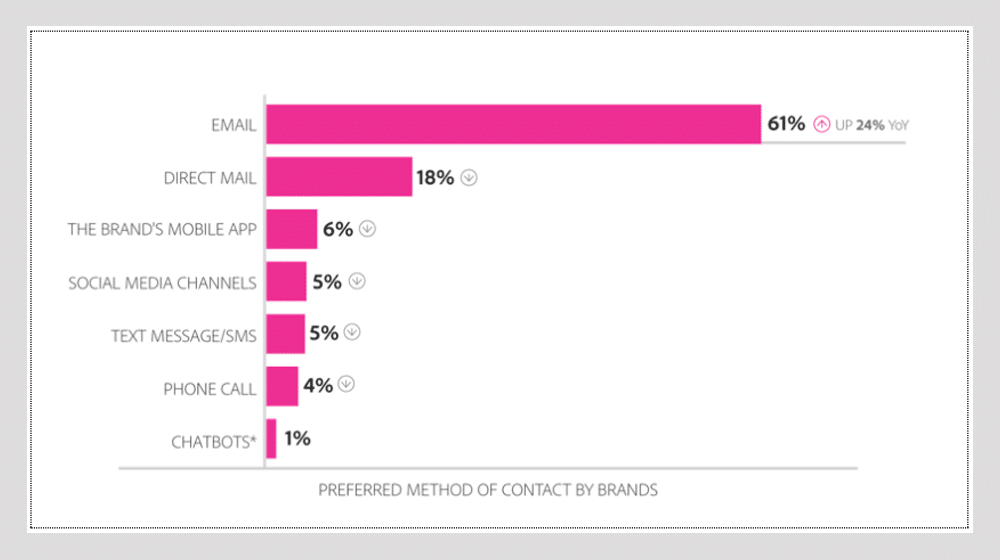91% of people check their inbox first thing in the morning so it makes sense that email marketing generates major return for most brands. To make the most out of your email marketing strategy, you need to develop a high-quality free email list.
But what does “high-quality” mean?
Your subscribers need to be engaged and they must have handed over their email address voluntarily. In this post, we’ll go over a few reasons why you shouldn’t purchase email addresses and then we’ll jump into a nice list of strategies for organic list growth.
What is a free email list?
A free email list refers to a list of subscribers that you’ve acquired without paying for email addresses. Basically, it means that everyone on your list gave you explicit permission to contact them.
Did you pay for a Facebook post that asked people to subscribe for your newsletter? The emails you acquired still fit into the “free” list category.
Did you purchase a list of email addresses from a third-party company? That is not a free list.
As social media algorithms continue to punish pages and limit organic reach, email continues to gain traction as one of the most effective forms of online marketing—and one reason why is because consumers know they can subscribe and unsubscribe at any time, no questions asked.
61% of customers prefer email for permission-based advertising. Facebook and Google offer minimal control to consumers over what content they see but with email, customers can unsubscribe at any time and completely control their preferences.
Source: Small Business Trends
Why you should never pay for email addresses
According to the 2019 Marketing Benchmark Report, 77% of organizations say that email is an effective tactic. Email is especially effective for small businesses: 51% of companies that rate email marketing as “very effective” have 50 employees or less.
Here’s the thing. All the amazing benefits of email marketing vanish when you purchase email lists.
From an ethical perspective, purchasing email lists is bad news. Not to mention, it’s illegal.
From a marketing perspective, purchasing a list—even if it wasn’t unethical and illegal—not sustainable and often counterproductive. Email works because people genuinely want to hear from you. When you contact people who never gave you their email address, they’ll just unsubscribe and mark you as spam.
When you continually get flagged as spam, this damages the credibility of your IP address—and every other organization sharing your IP address. In extreme cases, email clients like Gmail may blacklist your sending IP entirely.
Gmail, Apple, and other email clients are always developing new techniques and algorithms to rid inboxes of spam.
Organic list growth is the only way to maximize the benefits of email and keep email an enjoyable platform for everyone.
The 17 best strategies for ethical and effective organic list growth
Some tips below may fit perfectly with your organization’s industry and audience while others may not. Use the strategies that you think will really hit home with your specific audience.
Make it easy and enticing for your visitors to subscribe and watch your free email list grow.
1. Optimize your lead magnet.
Free PDFs like mini e-books, whitepapers, and how-to guides are excellent tools for grabbing email addresses. Check out what your competitors offer. Is there a way you can write something better or from a different angle? Is there a topic they’re missing that you know your audience would like to read about?
2. Put some of your best content behind a gate.
A lot of marketers write off gated content but there’s no rule about it being an all-or-nothing concept. Choose your best-performing or most in-depth blog posts, podcasts, and other content to capture email addresses.
3. Integrate your email efforts with your social media efforts.
Consider how you can combine your growth efforts. Feature user-generated content throughout your emails and social media profiles and how you can promote high-value content on your social media pages.
4. Add a QR code to stickers and printed marketing material.
Take your free email list growth to a new level with QR codes. Your cards and printed material can explain the benefit of your organization while the QR code makes it easy to subscribe.
Some people may not be willing to go through the hassle of typing a URL but scanning a code only takes a few seconds.
5. Install a slider or popup on your landing pages.
Integrating your signup forms into strategic locations around your website is crucial. Test out different types of signups (slider, popup, full page, etc.) and CTAs to see what works best.
6. Make it clear what kind of content subscribers can expect.
Do you mostly send promotions, curated content, tips, recipes, or blog posts? Explain what subscribers can expect from you—and how often you’ll send—before asking for an email address.
Notice how Thrive Market includes a tip just below their signup form.
Source: Thrive Market
7. Create different CTAs or lead magnets for various audience segments.
You don’t have to use the same copy for every audience. Break your visitors up into different segments based on behavior, location, industry, parental status, and other factors. You can create highly relevant lead magnets and signup CTAs to target specific groups.
8. Use a short code to place a signup form in strategic places around your website.
Some people instinctively click away popups and ignore sponsored advertisements. Instead, meet visitors where they’re at.
Place short codes in strategic locations around your blog and landing pages—like widgets in sidebars—to give your visitors plenty of opportunities to subscribe.
9. Offer free WIFI in your brick-and-mortar shop.
If you run a café, restaurant, or even a storefront, consider investing in high-speed internet and promoting free WIFI. You can ask visitors to provide their email address before accessing the free WIFI. Just make sure you get their explicit permission before adding them to your free email list.
10. Provide testimonials or social proof.
Once you’ve focused on organic growth for a while and acquired a nice number of subscribers, you can advertise how many people have already joined your list. Depending on your product, it may also be a good idea to include testimonials to encourage more people to subscribe.
11. Be up-front about your data and privacy policy.
People care about how you use and store their data—especially their email address. Make it easy for visitors to read about your data practices before they subscribe.
12. Start a loyalty or referral program.
Customers will gladly hand over their email address if it’s part of a broader program to get discounts or free products. Consider developing an app and incorporating it into your broader loyalty program and digital marketing strategy.
13. Participate in social media groups.
You can gradually build authority by engaging with prospects in Facebook and LinkedIn groups, not to mention Instagram, Snapchat, Reddit, and more. In addition to including a link to your signup form in your profile and featuring content from your newsletter, focus on having meaningful conversations with your fans and people will check out what you’re about.
14. Set up a table at an event.
Every industry has conferences, meetups, and expos. Set up a table at an event with marketing materials and a signup sheet for your mailing list. Depending on the rules of the event, you could also walk around with a signup sheet and talk to different guests.
15. Run an ad campaign to generate signups for your free email list.
Create an ad campaign with the specific purpose of generating newsletter signups.
Here’s the thing: A campaign like this doesn’t work best when you target random people based on interests or other factors. Instead, you’ll want to target people who already like or follow your page. Since they’re at least somewhat familiar with your brand, they’ll be more likely to subscribe.
16. Publish guest posts on relevant websites.
If you’re going for fast organic list growth, this isn’t your best choice. However, guest posting helps you get solid backlinks that last forever. The best guest posts contain evergreen content and are fully optimized for SEO.
17. Offer something to new subscribers.
Free stuff goes a long way. If you can’t offer a free product, provide a nice discount or free shipping.
Most top brands understand the importance of discounts and free stuff when capturing emails. Note how Under Armour offers free shipping to new subscribers.
Source: Under Armour
Wrap up
The bottom line is that you want to make it as easy as possible for people to subscribe for your list. At the same time, you also need to demonstrate the value of your list before people will feel comfortable handing over their email address.
- Leverage social media to build authority and boost sign-ups.
- Try some unorthodox methods with printed materials, in-person forms, and business cards.
- Clearly explain what subscribers can expect from your content.
Organic list growth is the driving factor behind every successful free email list and a few small tweaks can make a huge difference.
Are you ready to learn more about growing your email list? Read about the importance of focusing on high-quality subscribers rather than quantity.








